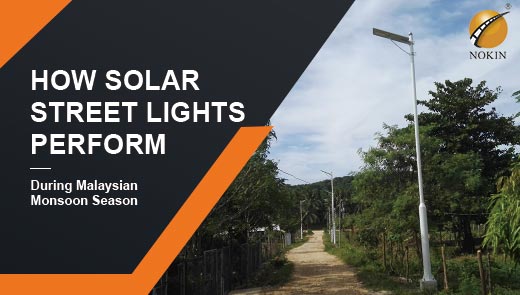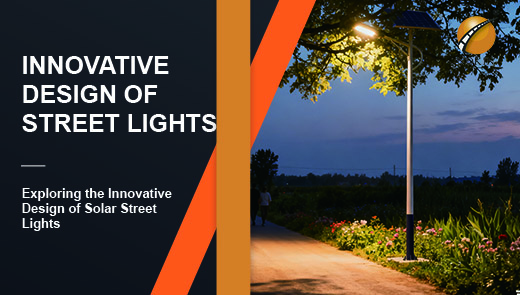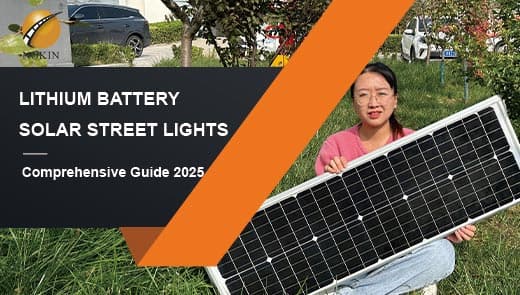How Solar Street Lights Perform During Malaysian Monsoon Season
Malaysia is located on the equator and has a distinctive climate - mainly tropical rainforest and tropical monsoon climate. The temperature throughout the year ranges from 26℃ to 30℃ with little fluctuation, and the rainy and dry seasons are clearly distinguished. The so-called monsoon season that people often talk about mainly refers to the period from March to June and from October to February of the following year.
For those working on solar street light projects, the most troublesome thing during the monsoon season is continuous rain, sometimes lasting for several days or even two or three weeks at a time. This kind of weather has a particularly direct impact on street lights: Firstly, the power generation cannot keep up. The continuous overcast days have greatly shortened the duration of sunlight. The solar panels receive insufficient solar radiation, and the power generation naturally decreases. This is also a common problem in the solar lighting rainy season. The more troublesome part is the energy storage. Due to insufficient power generation, the battery cannot be fully charged, but it still has to supply power to the solar street lights at night. As a result, the battery has to be deeply discharged over time. As a result, the battery life is bound to be affected. It's possible that the street lights will last for a shorter time at night and their brightness will decrease, making them very inconvenient to use in practice.
How Malaysian Monsoon Affect the Solar Street Lights Power Generation?
Monsoon Timing and Regional Differences
Northeast monsoon
From November to March of the following year, it mainly affects the east coast of the peninsula, the west coast of East Malaysia and the inland areas. The rainfall is concentrated and intense, often accompanied by strong winds.
Southwest monsoon
From May to September each year, it mainly affects the western part of the peninsula. Due to the barrier effect of Sumatra Island, there are mostly afternoon thunderstorms, with scattered and low-intensity rainfall.
Solar Irradiation Changes During the Monsoon Season
Solar irradiation is a key factor affecting the power generation of solar street lights. In Malaysia, solar irradiation during the monsoon season drops significantly compared to the dry season. During the dry season, solar irradiation can usually reach about 4-5 kWh/m²/day, while during the monsoon season, due to continuous rainy weather and clouds blocking sunlight, solar irradiation may drop to about 2-3 kWh/m²/day.
The Overall Impact of Monsoon on Power Generation
Under tropical monsoon climate, the power generation of solar street lights decreases by approximately 30% to 35%, which puts forward higher requirements for battery capacity, lifespan and system stability. If the battery capacity is insufficient or the battery life is shortened due to long-term and frequent charging and discharging, it may cause the solar powered street light to fail to work normally during the monsoon season, affecting its usage effect and reliability.
The Main Challenge of the Malaysian Monsoon to Solar Street Lights
The Power Generation Has Decreased Significantly
Continuous rainy days during the monsoon season lead to insufficient sunlight, resulting in a significant reduction in the amount of solar radiation received by solar panels and a decline in power generation efficiency. Insufficient power generation during the day limits the battery's energy storage capacity, shortens the lighting time and reduces its brightness at night, which affects traffic safety and social security.
The Battery Life Has Been Severely Affected
The reduction in power generation forces batteries to undergo frequent deep discharges. Under such working conditions, lead-acid batteries will accelerate their decline. The lead sulfate crystals accumulated on the electrodes are difficult to be fully converted, and their lifespan may be shortened by more than half. The LiFePO4 battery has a cycle life of 2,000 to 3,000 times, is resistant to high temperatures, and is less affected by deep discharge, thus performing better.
Panel Dirt Accumulation and Drainage Issues
Rainwater carrying dust and particles forms silt that covers the panels, resulting in a 20% to 30% reduction in power generation efficiency. If the drainage is not smooth, water accumulation around the panel will increase the risk of corrosion. If the rainfall is insufficient, the accumulated dirt cannot be effectively washed away, and it is necessary to rely on the open channel drainage system to ensure cleanliness.
Water Immersion Risk and Accessory Damage
In strong wind and rain, components with low IP ratings are prone to water ingress and short circuits. Waterproofing is crucial for solar street lights. The light body and junction box should at least reach IP65 grade. In coastal or high-humidity environments, IP66-IP68 grade should be selected. Meanwhile, the light pole should be made of corrosion-resistant materials such as aluminum alloy spraying and hot-dip galvanizing.
Wind Load Causes Mechanical Safety Hazards
The wind load generated by the strong monsoon wind will put pressure on the pile foundation and support of solar street lights. If the design fails to meet the wind load requirements, tilting and collapse may occur. Corrosion-resistant materials (such as aluminum alloy and stainless steel) should be selected based on local meteorological data, and the fixation condition should be inspected regularly.
Design and Selection Optimization Plan for Solar Street Lights in Malaysia
Increase the Remaining Capacity of Installed Capacity
- Solar panels: Select panels with larger capacity (for example, 200W can increase power generation by 50% to 80% compared to 100W), or stack the output current through parallel components to enhance power generation during the low irradiation period.
- Battery capacity: Calculated based on "continuous rainy days + standby days", it is recommended to support continuous rainy discharge for 3 to 5 days. For example, if a 30W street lightis illuminated for 10 hours a day, a 125Ah capacity battery should be configured under 12V voltage.
Preferred Battery Type
LiFePO4 batteries have obvious advantages over lead-acid batteries: long cycle life, high energy density, high temperature resistance, stable deep discharge performance, which can reduce maintenance frequency and cost, and are more suitable for the monsoon environment in Malaysia.
Optimize the Photovoltaic Panels and Installation Angles
Panel selection
Under the monsoon climate conditions in Malaysia, choosing high-efficiency monocrystalline PERC/TOPCon panels can significantly enhance the power generation efficiency of solar powered street lights. In practical applications, the power generation performance of TOPCon panels in low-light conditions is superior to that of PERC panels. They can capture more solar energy and convert it into electricity during the monsoon season when there is insufficient sunlight, providing more sufficient power for street lights.
Installation inclination Angle
Malaysia is located near the equator and has a relatively low latitude. The optimal installation inclination Angle for photovoltaic panels is generally between 0° and 20°. A reasonable tilt Angle can enable the panel to receive the maximum amount of solar radiation in different seasons, improving the power generation efficiency. Moreover, when the panel is set at a certain tilt Angle, rainwater can flow quickly, carrying away the dust and dirt on the surface, keeping the panel clean and reducing the decline in power generation efficiency caused by dirt accumulation.
Enhance the Protection Level
- Basic protection: The lightbody and junction box should at least reach IP65 grade, meeting the dust-proof and water-proof requirements of ordinary urban roads.
- Special environmental protection: In coastal and high-humidity areas, IP66-IP68 grade components are selected to resist strong winds, heavy rain and seawater erosion. Corrosion-resistant lightposts are used to extend the service life.
Apply Intelligent Control and Energy-saving Strategies
- Charge and discharge management: The adoption of a constant current and constant voltage charge and discharge manager can precisely control the charging current and voltage based on the battery status, preventing overcharging or overdischarging of the battery. This can effectively enhance the charge and discharge efficiency and lifespan of solar street lightbatteries.
- Dimming strategy: Nighttime graded lighting + dynamic dimming, automatic dimming at night, and full power restored upon PIR sensing people or vehicles. This can reduce power consumption by 30% to 40%, extend battery power supply time, and also enhance the safety and reliability of street lightusage.
Operation and Maintenance of Solar Street Lights and On-site Management in Malaysia
Clean the Panel Regularly
A comprehensive cleaning should be carried out once before and once after the monsoon. In areas with severe mud accumulation (such as construction sites and sections with heavy dust), the cleaning should be shortened to once every 1-2 months to avoid the impact of accumulated dirt on power generation efficiency.
Battery Inspection and Replacement
Regularly test the battery capacity with professional equipment. Replace it in time when it decays to 70%-80% of the rated capacity. Check the oxidation condition of the wiring and terminals, record the charge and discharge curves, and the battery status can be monitored in real time through remote monitoring.
Waterproof Sealing and Drainage Inspection
- Sealing inspection: Regularly replace aged or damaged sealing rings, clear blocked breathing valves, and repair cracked waterproof sealant at lead wires.
- Drainage guarantee: Clear debris from the drainage holes. Add drainage pipes and set drainage slopes in low-lying or water-prone areas to prevent water from soaking the equipment.
Regular Inspection
- Monthly inspection: Check the power generation voltage of the panel, the voltage and temperature of the battery, and observe the brightness and driving status of the lights.
- Quarterly inspection: Increase the inspection of mechanical fasteners (bolts, welding parts), verify the integrity of IP seals, and ensure the safety and stability of the system.
Actual Cases of Solar Street Lights in Malaysia
In a solar powered street light renovation project in a city on the east coast of Malaysia, the original system was not adapted to the monsoon environment, reducing the lighting time from 8 to 10 hours to 3 to 5 hours, and the capacity of the lead-acid battery declined by more than 50%. After optimization, adopt:
Increase the capacity of solar panels by 50% + parallel components;
Equipped with LiFePO4 battery, it can support continuous discharge for 5 days in rainy weather.
Apply a constant current and constant voltage manager + graded dimming strategy.Although the power generation during the monsoon season after optimization still decreased by 30%, the night lighting remained stable at 8 hours, the battery capacity declined by only 10%, and the maintenance cost was significantly reduced.
FAQ about Solar Street lights in Malaysia
Will solar street lights go out after continuous rainy days?
As long as the system design is reasonable, equipped with sufficient PV and battery capacity, high-quality batteries are selected and intelligent energy-saving strategies are applied, solar street lights can maintain basic night lighting during the continuous rainy period in Malaysia affected by the monsoon.
Is IP65 sufficient? When is IP67/68 needed?
For ordinary urban road conditions, IP65 grade is sufficient. However, in coastal areas, high-humidity environments, or scenarios prone to water accumulation and requiring frequent flushing, it is recommended to choose IP66-IP68 grade to ensure the waterproof effect of solar powered street lights.
Which battery should I choose, lead-acid or lithium?
Solar street light manufacturers suggest that if the budget allows and long-term reliability and low maintenance are pursued, LiFePO4 batteries should still be given priority. Lead-acid batteries are low in price but have a short lifespan and require frequent maintenance. As a result, their long-term usage costs are even higher. Especially for the special weather of long periods of continuous rain during the monsoon in Malaysia, lithium batteries are more cost-effective.




